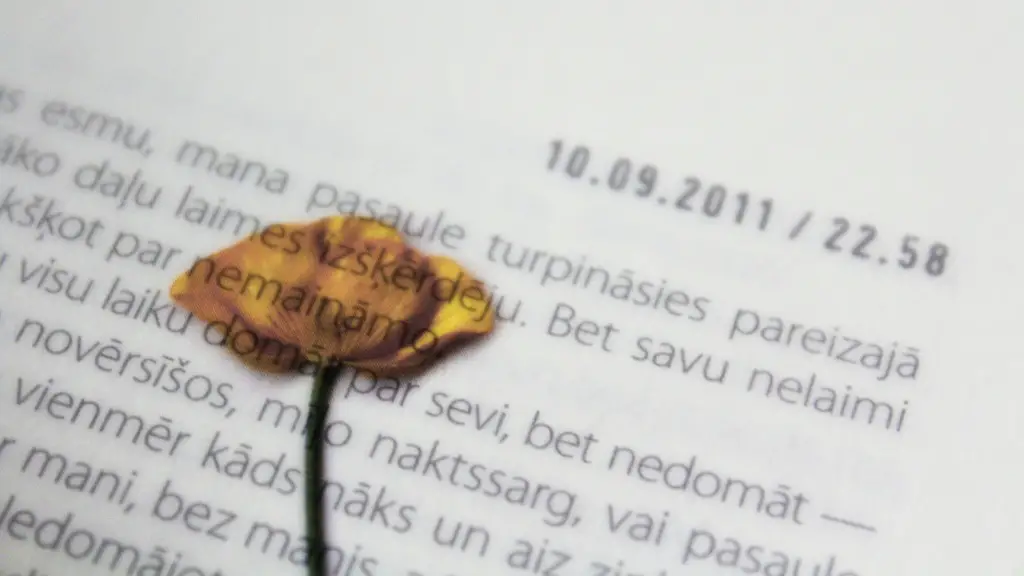In poetry, a stanza is a unified group of lines that creates a single poetic thought. It typically consists of multiple lines that share a particular rhyme scheme or structure. Stanzas are the building blocks of a poem and are often used by poets to express and develop various ideas and emotions. Put simply, a stanza is a poetic unit that conveys a single, unified thought.
The word “stanza” is derived from the Italian word “stanza” which means “room”. This term was first used by Italian poet Francesco Petrarca in the 14th century. The use of the stanza was common in Italian, Spanish, and French poetry of the time. The first usage of the word in English poetry was in the early 17th century.
A typical stanza consists of two or more lines of poetry. Each stanza can range in length from a single word to multiple lines. The length is determined by the poet’s intent and style. The number of lines in a stanza can be varied, but it is usually consistent throughout the poem.
In poetry, stanzas are used to create a particular rhythm and structure. They can often be seen as self-contained units that are connected to one another. Different stanzas may have different rhyme schemes, line lengths, and patterns of meter. This helps the poem flow more smoothly and enhances the overall effect of the poem.
Stanzas can also be used to create powerful and vivid imagery. By using particular words, images, and symbols within the stanza, the poet can create a more powerful effect and elicit a particular response from the reader. The combination of multiple stanzas can also create a cumulative effect, making the poem more powerful and emotionally charged.
In addition to being used for structure, stanzas can also be used to express emotions and feelings. By choosing words carefully, a poet can create a stanza that conveys a particular emotion in an innovative way. This allows the poet to better express and develop the desired emotion or thought.
Types of Stanzas
There are many different types of stanzas which vary in length and structure. Some of the most common include couplets, tercets, quatrains, and quintains. Each type of stanza has a particular rhyme scheme and meter.
A couplet is a two-line stanza that typically has a rhyme scheme of A-A. This type of stanza has been used by poets for centuries and is one of the most basic and commonly used structures. An example of a couplet can be found in Shakespeare’s sonnet 18:
“Shall I compare thee to a summer’s day?
Thou art more lovely and more temperate.”
A tercet is a three-line stanza. It often has a rhyme scheme of A-B-A, although this is not always the case. An example of a tercet can be found in Wordsworth’s “Daffodils”:
“I wandered lonely as a cloud
That floats on high o’er vales and hills,
When all at once I saw a crowd,”
Quatrains
A quatrain is a four-line stanza. It is commonly used in poetry and often has a rhyme scheme of A-B-A-B or A-B-A-A. An example of a quatrain can be found in Matthew Arnold’s “Dover Beach”:
“The Sea of Faith
Was once, too, at the full, and round earth’s shore
Lay like the folds of a bright girdle furled.
But now I only hear its melancholy, long, withdrawing roar…”
Quintains
A quintain is a five-line stanza. It is often used in rhyming poetry and has a rhyme scheme of A-B-A-B-A or A-B-B-A-A. An example of a quintain can be found in Robert Frost’s “Stopping by Woods on a Snowy Evening”:
“The woods are lovely, dark and deep.
But I have promises to keep,
And miles to go before I sleep,
And miles to go before I sleep.”
Free Verse
In addition to traditional rhymed stanzas, there is another type of stanza known as free verse. Free verse stanzas often do not have a specific rhyme scheme or meter. Instead, they rely on the poet’s choice of words and phrasing to create a specific effect. Walt Whitman is one of the most famous practitioners of free verse poetry.
Many contemporary poets choose to use free verse stanzas in their work. This allows them to express ideas and emotions in a more creative and innovative way. By combining free verse stanzas with traditional rhymed stanzas, poets can create poems that are both lyrical and thought-provoking.
Benefits of Stanzas
The use of stanza has a wide range of benefits for poets. By using stanzas, poets can create more powerful and effective poems. They can also use stanzas to express their ideas and emotions in a more effective and engaging way. By combining various stanza types, poets can create poems that are truly unique.
Stanzas can also help structure a poem and make it more cohesive. By using particular stanza lengths, rhyme schemes, and meter, poets can create a poem that is more unified and flows more smoothly. This can help the poet achieve their desired effect.
The use of stanzas is not limited to poetry. They can also be used to create powerful and vivid stories, as well as songs. By combining different stanza types in a creative and innovative way, writers and musicians can create stories and songs that are both engaging and emotionally resonant.
Conclusion
In summary, a stanza is a unified group of lines in a poem that conveys a single, unified thought. It typically consists of multiple lines that share a particular rhyme scheme or structure. There are many different types of stanzas which vary in length and structure. These include couplets, tercets, quatrains, and quintains. In addition to traditional rhymes stanzas, there is also a type of stanza known as free verse. The use of stanza in poetry has a wide range of benefits for poets, as it can help create more powerful and effective poems, as well as structure stories and songs.





